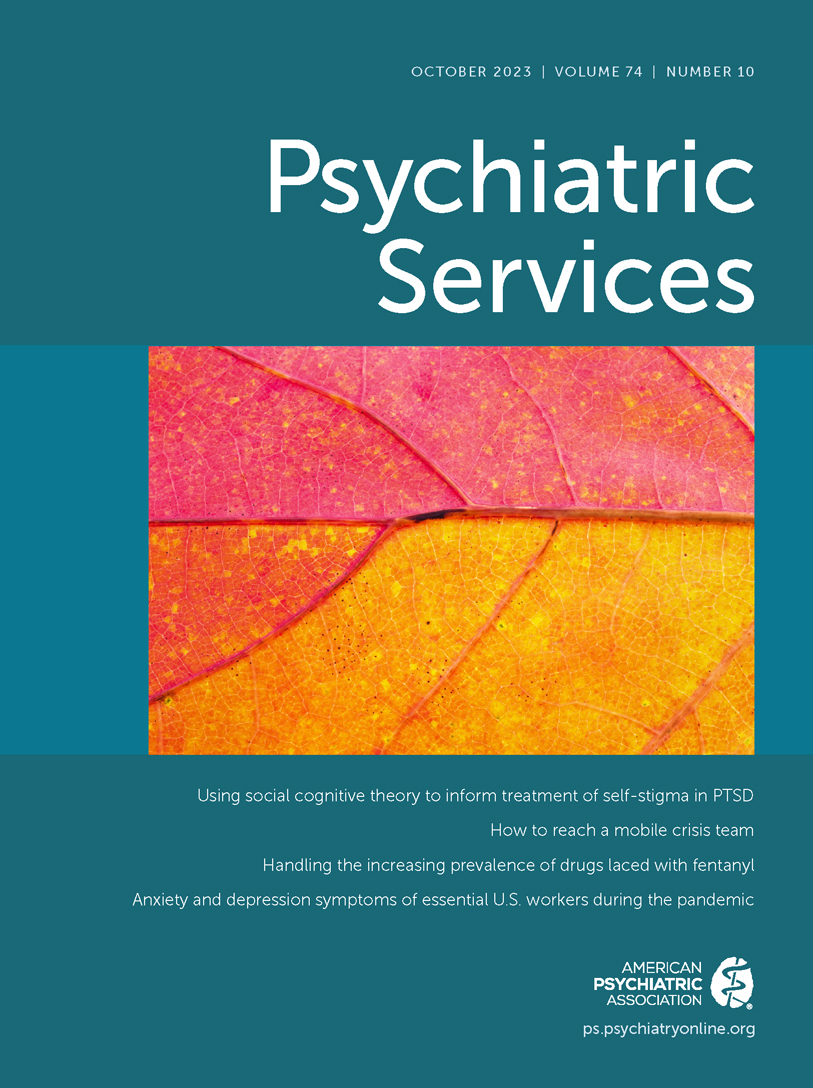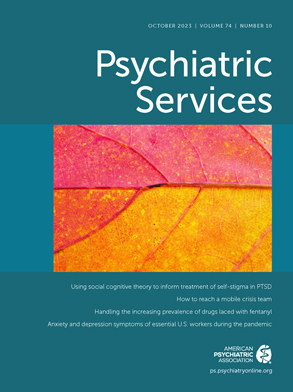Demographic trends show a rising number of people who need long-term psychiatric care for
DSM-5 diagnoses that result in functional impairment that substantially interferes with one or more major life activities (i.e., severe mental illness, including schizophrenia spectrum disorders and bipolar disorders). For many, family involvement is central to recovery because family members often play a primary role in helping their loved ones seek and engage with mental health services and meeting their loved ones’ needs outside those services (e.g., rides to appointments, emotional support, and occasional assistance with basic activities of daily living). When caregivers fulfill this role, they often experience sleep problems, depression, stress, cognitive impairments, anxiety and panic attacks, pain, and numerous other mental health challenges, particularly when providing more involved care (
1). Caregivers may even come to resent their loved ones (
2). Thus, strategies to support a person’s recovery from severe mental illness—and those focusing on the experiences of a person with the diagnosis—should address caregivers’ mental health as well. That is, improvement of the mental health of caregivers would invariably have a positive impact on the people they care for; yet, studies have rarely examined this connection.
Underutilization of Mental Health Services by Asian American Caregivers
Asian Americans are particularly prone to caregiving strains. By 2060, the population of Asian Americans is expected to reach 46 million, nearly four times the current population. Despite the rapid growth of this population in the United States, scant research involving Asian American participants has been published (
3). Caregiver roles are often defined by filial piety (duty and responsibility toward one’s family) and family cohesion (closeness with one’s family; e.g., cohabiting with family members and prioritizing family responsibilities over personal needs), leading to more intimate and stressful caregiving arrangements. For instance, Lin and colleagues (
4) examined family involvement in the treatment of patients with schizophrenia, finding that Asian family members were more intimately involved in caregiving for their loved ones compared with non-Hispanic White family members. Studies also indicate that Asian American caregivers experience higher levels of caregiver burden and mental health challenges compared with non-Hispanic White counterparts (
5).
Few studies have specifically explored mental health outcomes among Asian American caregivers; however, one common finding is the underutilization of mental health services, which further exacerbates the experience of mental health burden. Stigma attached to mental illness and service use is a major deterrent to help seeking among Asian Americans, leading to increased depression symptoms, decreased social support, misconceptions about mental health issues, and lack of knowledge about mental health resources. These undesirable outcomes call for targeted psychoeducation and antistigma interventions (
6). Several interventions have been developed to reduce stigma among caregivers in the general population, and these interventions have been implemented primarily among non-Hispanic White groups. Although preliminary antistigma efforts have been conducted among some Asian groups (e.g., a tailored psychoeducation program for Chinese immigrants, altered to integrate Chinese concepts into the intervention and shortened because of work demands of immigrant families) (
6), further research is needed to continue exploring their effectiveness among these racially minoritized communities.
Disaggregating data about Asian Americans into ethnic subgroups remains an ongoing challenge because each community has a unique social history in the United States that has distinct implications for use of mental health services within these communities. Moreover, certain Asian American subpopulations experience different levels of stigma, shame, and oppression. For instance, one study showed that Vietnamese American individuals were more vulnerable to mental distress compared with Chinese, Asian Indian, Korean, Filipino, and other Asian groups in the United States (
7). Although the authors of that study did not specifically examine caregiving among Asian American subgroups, more research should be conducted to investigate whether certain ethnic groups are more prone to caregiver stress, which can inform more targeted interventions.
Associations Between Caregiving Experiences and Mental Health
We systematically reviewed the literature for quantitative studies that evaluated mental health outcomes among Asian American caregivers supporting a family member with severe mental illness. We systematically searched five databases since inception (PsycINFO, PubMed, Ovid, ProQuest, and Google Scholar) using MeSH and PICO (patient or population, intervention, comparison, and outcomes) terms; database thesauri; and the keywords “Asian American,” “severe mental illness,” “caregiver,” and “mental health.” Eligible studies had to have been published as peer-reviewed journal articles; gray literature, conference proceedings, books, and dissertations were excluded. Articles had to have focused on the mental health of caregivers as an outcome to meet inclusion criteria.
Following our systematic search, only three articles were identified. First, Kung (
8) conducted a mixed-methods study with 30 Chinese American caregivers of family members with schizophrenia, exploring caregiving burden, social support, and family coping as well as mental health outcomes. The author highlighted the need for cultural understanding regarding a caregiver’s length of stay in the United States, language proficiency, and knowledge of community resources for coping with stress.
Second, a comparative study conducted by Han and colleagues (
5) examined the similarities and differences between non-Hispanic White and Chinese American caregivers in caregiving burden, affiliated stigma, structural barriers to help seeking, coping resources (i.e., self-care practice and social support), and mental health. The authors underscored the need for mental health professionals to develop culturally tailored intervention programs to support family caregivers identifying as Asian American; moreover, their findings showed that different factors predicted mental health outcomes among Asian American groups compared with a non-Hispanic White group and that different social supports and coping strategies were accessed. Asian Americans were more likely than non-Hispanic Whites to experience stigma and structural barriers to health care; as a result, the authors emphasized the importance of expanding research with Asian American caregivers of individuals with severe mental illness, given the unique cultural needs of this population.
Last, Han and colleagues (
1) conducted a cross-sectional study examining wellness and attitudes toward caregiving among a sample of 116 Asian American caregivers of family members with severe mental illness. They found that higher levels of self-efficacy were related to more positive attitudes about caregiving, which, in turn, contributed to enhanced overall well-being. These results further support the value of prioritizing caregivers’ mental health, with the goal of promoting overall well-being among families affected by severe mental illness. Of note, we only searched for quantitative studies; in the future, researchers should consider reviewing gray literature and other publication types to further explore these topics.
Culturally Responsive Service Delivery and Future Research
The findings from this preliminary search highlight important gaps to address when considering development of future research in this area. First, all three studies used convenience sampling, indicating the need for researchers to conduct studies with other sampling methods and to include members of Asian American communities whose experiences have not been captured in the literature to date, including those with limited English proficiency. Participants in the three studies mostly identified as Chinese Americans, and findings were not generalizable to other Asian American subpopulations.
Second, the body of extant literature does not differentiate caregiver roles, because all studies included individuals who self-reported being a caregiver of a family member and did not report the level, scope, or intensity of caregiving. No validated measure of level of caregiver commitment has yet been empirically examined with an Asian American sample. An exploration of variation in caregiver roles could illuminate how such roles affect mental health outcomes, quality of life, and overall well-being of caregivers and their family members with severe mental illness.
Third, mental health outcomes are not currently defined clearly in the context of the caregiver experience. Studies have explored caregiver “burden” without articulating whether and how burden constitutes or gives rise to psychopathology. Furthermore, other commonly researched mental and behavioral health outcomes (e.g., substance use, depression, stress) have not been evaluated among Asian American caregivers, and research toward this end could inform interventions.
Following these findings, in future studies, researchers can explore ways to adapt existing therapeutic interventions and stigma-reduction strategies for Asian American families to enhance culturally responsive service delivery. These efforts could increase the appeal and use of mental health services among this population. As earlier discussed, linguistic and cultural barriers often lead to reduced help-seeking behaviors and delayed onset of care; as a result, enhanced provision of culturally responsive services would be strengthened by prioritizing the training of clinicians fluent in a family’s native language (e.g., Mandarin, Cantonese, Korean, Japanese, Tagalog, Lao).
We underscore the importance of developing culturally sensitive psychoeducation and stigma-reduction strategies for Asian American families. For instance, tailored clinical efforts can include amelioration of language barriers (e.g., materials in Asian languages, translation services, cultural matching with providers); consultation with members of the community (e.g., faith-based leaders, members of local language schools); and referrals to holistic practitioners who use Eastern, complementary, or integrative approaches. Interventions may also be administered through telehealth, which can help reduce the stigma of having to wait in a clinic, accommodate work schedules of families who work in small businesses or the service sector, enable transcription and translation services, and accommodate “astronaut” family arrangements (i.e., members of a family living in different places).
Future research must also involve Asian American communities through a bottom-up framework. Such a framework could include direct involvement of Asian American community partners, local services, organizations, and leaders via community-based participatory research approaches. Potential efforts to reduce stigma within Asian American communities could entail provision of linguistically accessible workshops, peer-provider programs, support groups, group therapy at faith centers and other cultural venues (e.g., Ending Self-Stigma), and social marketing (e.g., social media campaigns to raise awareness and increase visibility of mental health services). Other approaches requiring more experimentation could include entertainment education tailored to Asian audiences (e.g., educational soap operas [such as Korean dramas] similar to the fotonovelas previously used in Latinx communities).
Adaptation of extant evidence-based practices could further support the culture-specific needs of Asian American caregivers. For example, Open Dialogue appears to be a useful framework for families affected by schizophrenia spectrum disorders (
9); this model encourages active listening, sharing of experiences with a nonjudgmental group, and provision of social support, with the goal of improving mental health outcomes for all family members involved. Yet, to our knowledge, no attempts have been made to adapt this intervention for specific Asian American cultures or to evaluate the feasibility and effectiveness of this intervention for Asian American communities. Cultural tailoring of the Open Dialogue framework would necessitate antistigma efforts because many Asian American cultures often discourage sharing of private matters as a result of high levels of mental health stigma.
In addition, Asian Americans who practice Buddhism may be particularly amenable to cultural adaptations of existing mindfulness-based interventions (such as acceptance and commitment therapy); such adaptations may facilitate a natural extension of their own spiritual practices and represent a palatable approach to mental health care that incorporates these individuals’ cultural values. Cultural competency training for clinicians that addresses the culture-specific needs of various Asian American subpopulations could bolster the quality of mental health services available to Asian American caregivers in need of support.
Finally, we stress the importance of acknowledging intersectionality because varying combinations of social categorization, not solely racial-ethnic identity, inevitably influence an individual’s access to health care and overall mental health outcomes. Professionals must recognize the role of various social determinants of health because they affect service access and related disparities in care. We call for a new research agenda to explore and enhance the provision of culturally responsive services to caregivers of family members with severe mental illness, and we underscore that enhancing caregivers’ well-being and mental health is a way of promoting a holistic and community-oriented recovery process.

